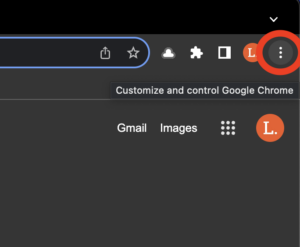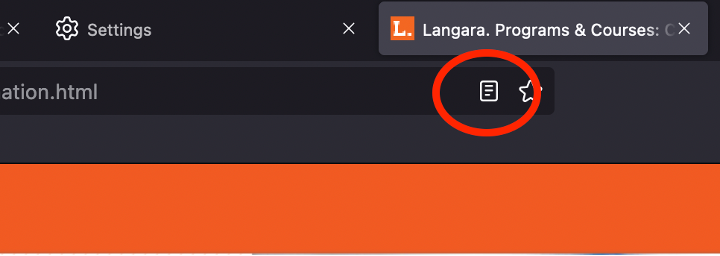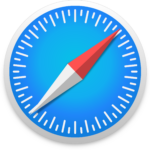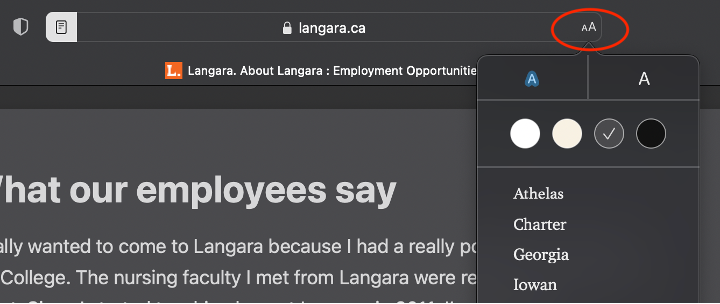Assistive Technology User Guides
Browsers

While they are not specifically assistive technology, browsers have settings and tools that can make navigating the internet easier. The following guides refer to desktop (Windows and macOS) use, but some similar features are available in the mobile versions of each.
On this page:
Chrome
![]() Chrome is the most commonly used browser and has the greatest compatibility with assistive technology.
Chrome is the most commonly used browser and has the greatest compatibility with assistive technology.
To find settings and tools, select Customize and control Google chrome (3 vertical dots near top right) or press ALT f.

Page Zoom
Zoom in: Control (Command on macOS) and =
Zoom out: Control and –
Reset to actual size: Control and 0
The zoom settings can also be accessed by the View menu on the toolbar (macOS) or under More on Windows.
Chrome will remember your zoom level on a specific webpage. Simply zoom to your desired zoom level and when signed in on your device the page will load to that zoom level. To reset default zoom to 100% follow these steps:
- Select More > Settings
- Click Privacy and security > Site Settings
- Click Additional content settings > Zoom levels
- Click X (Remove zoom level) to reset default zoom to 100%
Default Fonts
- Select More > Settings
- Select Appearance
- Font Size allows users to set font size
- Additional options are available under Customize fonts
- Minimum font size
- Default font styles
Live Caption
Chrome includes an automatic captioning tool for videos. The captions are not a substitute for proper captioning of videos but may be a useful tool for users when encountering an uncaptioned video. To enable:
- Select More > Settings
- Select Advanced > Accessibility > Captions
- Turn on Live Captions
Chrome live captions uses the operating system’s default captioning.
Get Image Descriptions
When running a screen reader, Chrome may be able to provide image descriptions for images lacking alt text. Follow the instructions to enable this setting. The descriptions are machine generated and may not be accurate.
Highlight Focused Elements
When navigating with a keyboard, Chrome can show a highlight of links, menus, and buttons when focused and selectable. To enable:
- Navigate to Settings
- Select Advanced > Accessibility
- Turn on Show a quick highlight on the focused object
Caret Browsing
Press F7 to activate caret browsing, allowing the keyboard to move around and select text.
UI Options Plus
UI Options Plus is a Chrome extension that provides many visual customizations in one interface. Use the scrollbar or left and right arrows to move between tools. The following options are available:
- Zoom – uses Chrome browser zoom up to 500%.
- Letter spacing – up to 2x website default.
- Word spacing – up to 4x website default.
- Line spacing – up to 3x website default.
- Syllables – Divides words by placing a dot between syllables.
- Contrast – Offers multiple combinations of background and text colours.
- Right-click to select – Allows users to select text block by right-clicking on any part of it.
- This may help users employ text-to-speech software on a specific bit of text and/or assist with copying.
- Selection highlight – Allows users to change the default colour when highlighting text.
- Text-to-speech – Toggle this tool to use text-to-speech on highlighted text. Click the Play button to hear text.
- Reading mode – Toggle reading mode to simplify the page and remove distractions like ads or sidebars (note: this could break the layout of some pages).
- Table of contents – This tool generates a table of contents for the page using the page’s heading structure.
- Enhance inputs – This toggle makes link and button text larger, bold, and underlined.
Customizations can be changed by clicking left or right arrows, entering a numerical value in the textbox, or toggling setting on or off.
To reset all customizations to default, right-click the extension icon and choose Reset.
Links
Overview of accessibility features in Chrome
Edge
 Edge is the default browser of Windows 10/11. Edge is built on the same software engine as Google Chrome and so many features and settings are the same and Chrome extensions will run in Edge.
Edge is the default browser of Windows 10/11. Edge is built on the same software engine as Google Chrome and so many features and settings are the same and Chrome extensions will run in Edge.
To find settings and tools, select Settings and more on the toolbar or press ALT and f.
Page Zoom
To zoom in: Press Control (Command on macOS) and =
To zoom out: Press Control and –
To reset to actual size: Press Control and 0
Additionally, open Settings and more button and click the + or – on the Zoom line of the menu.
Default Fonts
- Navigate to Settings
- Select Appearance from the sidebar
- Navigate to Zoom
- Select Page zoom dropdown to set default zoom percentage
- Navigate to Fonts
- Select Font size dropdown to change default font size.
- Select Customize fonts for additional options.
Read Aloud
Microsoft Edge has a built-in reader mode. Read Aloud allows you to have text read aloud. Immersive reader is a distraction free reading mode that also reads text aloud. To start Read Aloud, select text or right click where you would like to begin reading and select Read aloud.
The read aloud toolbar will appear at the top of the screen, allowing users to pause, skip ahead or back, and change voice and speed options.
Read aloud can also be opened by pressing Control and Shift and u.
Read more about Edge Read aloud.
Immersive Reader may not be available on all webpages, but when it is an icon of an open book with a speaker on it will appear in the address bar. To open immersive reader, you can click on the icon or press F9.
In immersive reader a toolbar appears at the top of the page that contains options to change text size and spacing, font style, and page colour themes. Additionally, there are grammar, focus, and pronunciation options.
Keyboard Navigation
- Open Settings
- Navigate to Accessibility in the sidebar
- Navigate to Keyboard
- Toggle Navigate pages with a text cursor on.
Use F7 to activate caret browsing. Caret browsing allows the keyboard to move a cursor within text on the web and select text to be highlighted or copied.
Firefox
 Firefox is a web browser that is not based on the Chromium engine, as such does not support the same extensions, settings, and keyboard shortcuts. However, Firefox is still a popular browser and has many excellent features (including built-in text to speech) and is highly customizable.
Firefox is a web browser that is not based on the Chromium engine, as such does not support the same extensions, settings, and keyboard shortcuts. However, Firefox is still a popular browser and has many excellent features (including built-in text to speech) and is highly customizable.
Page Zoom
To zoom in: Control (Command on macOS) and =
To zoom out: Control and –
To reset to actual size: Control and 0 or click the x% icon in the address bar
Or, hold Control (Command on macOS) and scroll up (with mouse wheel or two fingers on trackpad) to zoom in and scroll down to zoom out.
Firefox allows users to zoom text only (Navigate to View menu > Zoom > Zoom Text Only). Use the same keyboard shortcuts as above. Keep in mind, this may break the layout and functionality of a webpage.
More information about zooming in Firefox.
Via Settings > General under Language and Appearance changed the Default Zoom for all pages using the dropdown menu. Read the Firefox Font size and zoom guide for more information.
Default Fonts
To set minimum font size:
- Navigate to Settings and move to the Language and Appearance section.
- Under Fonts and Colours, select Advanced… button.
- In the Minimum Font Size drop-down select the minimum size in pixels for text.
- Uncheck Allow pages to choose their own fonts, instead of their selections above.
- Click Ok.
Read more about Firefox minimum text size options here.
To override page font styles:
- Open Settings.
- Under Language and Appearance > Fonts and Colours, select Advanced.
- Set the various fonts you would like to use.
- Uncheck Allow pages to choose their own fonts, instead of their selections above.
- Click Ok.
Firefox guide for overriding page fonts.
Default Colours
Firefox allows users to set default colours for text, backgrounds, and links.
- Navigate to Settings
- Under Language and Appearance, select Colours button.
- Set your specified colours for each and then select the Override the colours specified by the page with your selections above dropdown and set to Always.
More information on overriding page colours.
Reader View
Firefox offers a Reader View on many pages. This feature strips the page down to text and important images and allows user to change the background colour, font style, text size, text alignment, and spacing. When you see a page icon in the address bar, Reader View is available.

Select the icon or press CTRL and ALT and R (CMD and OPT and R on mac OS)
A floating toolbar appears on the simplified page with options to modify appearance and have the content read aloud via text to speech.
Read more about Firefox Reader View.
Page Viewing
Firefox allows users to view the page with style elements removed.
Select View > Page Style > No Style to see the webpage with styling removed (text, links, and images only)
Keyboard Navigation
Firefox, like most modern browsers, allows users to move focus between links, buttons, menus, and other interactive elements using Shift (and Shift + Tab together to move back).
Pressing F7 toggles Caret browsing on or off. This feature allows users to move a cursor through the content of a webpage and select text as if they were in a text editor.
Read more about keyboard navigation in Firefox.
Search
To search within a webpage, press Control (Command on macOS) and f to open the search field. You can also use / for quick search with fewer options. Press ‘ to search only links on the page, this may be useful to quickly skip to a section of the page.
Press Escape to close the search tool.
Eye Dropper
Windows:
- Select Open Application Menu
- Open More tools
- Select Eyedropper
macOS:
- Select Tools
- Choose Eyedropper
Using the magnified view that appears, click on a colour. The HEX colour code will be automatically copied to your clipboard to be pasted in another application.
Copy Text from Image (macOS only)
- Right-click on an image
- Select Copy Text from Image
- A popup containing the image’s text appears
- The complete text is automatically copied to the clipboard
- Or, you can select just part of the text and copy with CMD C
- Click Close or press Escape
Known Issues
- Firefox is a highly customizable browser, however as it is not as popular as Google Chrome and not built on the same software engine, some web pages and functions may behave differently.
- Some developers only build extensions for Chrome and as such many extensions are not available for Firefox.
Links
Accessibility features in Firefox overview.
Mouse shortcuts for Firefox (zoom, navigate back and forward, manipulate tabs)
Access Firefox: Accessibility resources and links for Firefox users.
Safari
 Safari is the built-in web browser on macOS, iOS, and iPadOS. Safari lacks many of the extensions available for Chrome, but offers some proprietary features not available on other browsers.
Safari is the built-in web browser on macOS, iOS, and iPadOS. Safari lacks many of the extensions available for Chrome, but offers some proprietary features not available on other browsers.
Page Zoom
To zoom in: Command and =
To zoom out: Command and –
To reset to actual size: Command and 0
Safari also offers options to zoom text only however this often breaks the layout and functionality of webpages.
Minimum Font Size
- Safari > Preferences…
- Advanced Tab
- Check Never use font sizes smaller than and set size in drop down box.
Set defaults for current site
- Select Safari from the menu bar
- Select Settings for [current website]
- You can select Use Reader when available and set default zoom with Page Zoom
Website specific settings can be amended or removed later via Safari > Preferences > Websites
To set defaults for all webpages:
- Navigate to Safari on the menu bar
- Select Preferences
- Move Websites tab
- Select Page Zoom from sidebar
- In the bottom right, choose a default zoom percentage using the dropdown menu beside When visiting other websites:
- The same process can be used to use Reader View when available by navigating to Reader in the sidebar and selecting On in the When visiting other websites: dropdown.
Learn more about customized settings for websites in Safari
Reader View
When available, Safari can display pages in a simpler, reader-friendly view.
Look for a page icon in the address bar and select it.
Alternatively, you can press CMD and SHIFT and R when the option is available.
In the address bar, select Aa icon to customize your reader view.
Learn more about Safari Reader View.
Text to Speech
Highlight text and select Edit > Speech > Start Speaking or right-click > Speech > Start Speaking
You can also use the Start Speaking tool before highlighting text, however some webpages may begin reading at odd points.
Select Edit > Speech > Stop Speaking to stop text to speech.
Change voice options via System Preferences > Accessibility > Spoken Content
Keyboard Navigation
To enable keyboard navigation on macOS
- Navigate to System Preferences > Shortcuts tab
- Check Use keyboard navigation to move focus between controls checkbox.
Open Safari
- Navigate to Safari in the menu bar and select Preferences
- Navigate to the Advanced tab
- Under Accessibility, check Press Tab to highlight each item on a webpage checkbox.
- Useful shortcuts:
Reload current page: Command and r
Move focus to address bar: Command and l
Move back one page: Command and [
Move forward one page: Command and ]
Move down the page vertically: Spacebar
Move up the page: Shift and Spacebar
Links
Apple Accessibility knowledge base

